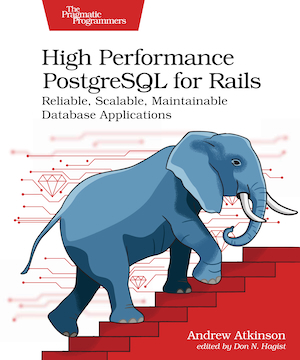- Steps
- Running
pg_upgradewith--check - Checksums
- Errors with extensions
- Having a cluster install user
- Locale provider mismatch
- Encodings mismatch
- Final
initdbcommand with flags - Closing Thoughts
PostgreSQL 15 shipped in late 2022 (See PostgreSQL 15 Release Notes), including interesting new features like SQL MERGE. I wanted to give them a try.
On my Mac, I was running PostgreSQL 14.3 and had some significant databases I wanted to preserve but have them running on 15.
To perform the upgrade, I used pg_upgrade which ships with PostgreSQL. To initialize, install, and manage the cluster on Mac OS, I use Postgres.app.
Postgres.app installs PostgreSQL in versioned directories. I had separate directories for versions 14 and 15.
Postgres.app has an “Initialize” button that creates a new cluster. I imagine this runs initdb behind the scenes.
During my upgrade, I ended up running initdb manually so that I could directly set specific flags. See: initdb Documentation
To get started, check which version of pg_upgrade is active.
$ which pg_upgrade
/Applications/Postgres.app/Contents/Versions/14/bin/pg_upgrade
If the old version is active, make sure to use pg_upgrade from the new PostgreSQL 15 version.
Steps
- Download and install Postgres.app. This is a regular Mac OS app with a
.dmg. - Choose “Replace” during installation. You are replacing the Mac OS app, not modifying the current PostgreSQL cluster.
- Open Postgres.app. Choose the “+” icon. Version 15 is now available. Click the plus button to create a new cluster. In PostgreSQL the collection of databases is a “cluster.”
To make the versions easier to keep track of, I renamed both clusters, my_db_14, and my_db_15. Both ran on the same port so I ran one at a time.
Stop any running copies of 14. I use the pg_ctl program, -D and a path to the data directory.
pg_ctl stop \
-D "/Users/andy/Library/Application\ Support/Postgres/var-14/"
While running “Initialize” from Postgres.app is possible, I had inconsistencies flagged by pg_upgrade between the cluster versions.
In the end, I did not initialize the cluster from the app, but ran initdb with various flags.
The data directory for version 15 is below.
/Users/andy/Library/Application\ Support/Postgres/var-15
Stop both versions before performing the upgrade. Stop the version 15 cluster if it’s running.
pg_ctl stop \
-D /Users/andy/Library/Application\ Support/Postgres/var-15
Running pg_upgrade with --check
Run pg_upgrade with the --check option to perform a dry run. Provide the data directory and the binaries directory for both clusters.
This means there are 4 arguments to pg_upgrade besides --check.
The full command with the version 15 pg_upgrade and all 5 arguments is below.
/Applications/Postgres.app/Contents/Versions/15/bin/pg_upgrade \
--check \
--old-datadir "/Users/andy/Library/Application Support/Postgres/var-14" \
--old-bindir "/Applications/Postgres.app/Contents/Versions/14/bin" \
--new-datadir "/Users/andy/Library/Application Support/Postgres/var-15" \
--new-bindir "/Applications/Postgres.app/Contents/Versions/15/bin"
Checksums
One issue I ran into was with checksums.
The error was "the old cluster does not use data checksums but the new one does".
What I did was to disable checksums for the new 15 cluster. I don’t fully understand the implications of this, but since this is for my local installation, I’m not worried about it for now.
To disable checksums I ran the following command.
/Applications/Postgres.app/Contents/Versions/15/bin/pg_checksums \
--disable \
-D "/Users/andy/Library/Application Support/Postgres/var-15"
Errors with extensions
The next error I had was with pg_cron, which is an extension I’d compiled for PostgreSQL 14.
FATAL: could not access file "pg_cron": No such file or directory
I’d set up citusdata/pg_cron in 14, so I’ll need to set that up in 15 as well.
I confirmed it wasn’t listed in available extensions, from a psql prompt in 15. I disabled it initially to make the upgrade easier, but was able to recompile it for 15.
The other items in shared_preload_libraries for me are items that ship with PostgreSQL (pg_stat_statements, and auto_explain).
SELECT * FROM pg_extension;
I needed to modify my path to make sure the version 15 directory was active.
export PATH=$(which pg_config):$PATH
I followed the normal build from source instructions for citusdata/pg_cron.
Once that completed, I added it to the new postgresql.conf config file.
vim "/Users/andy/Library/Application\ Support/Postgres/var-15/postgresql.conf"
# edit shared_preload_libraries
shared_preload_libraries = 'pg_cron' # (requires restart)
Now I can start PostgreSQL 15 again.
/Applications/Postgres.app/Contents/Versions/15/bin/pg_ctl start \
-D "/Users/andy/Library/Application Support/Postgres/var-15"
Having a cluster install user
I needed to create a postgres superuser for the upgrade.
"FATAL: role "postgres" does not exist".
I solved this by adding --username postgres to the initdb command.
Locale provider mismatch
The next error was a mismatch in the locale providers between the versions.
"locale providers for database "template1" do not match: old 'libc', new 'icu'".
I solved this by adding no-locale to initdb, and running it directly on the new data directory.
Encodings mismatch
The next issue was a mismatch in the encodings between the clusters.
"encodings for database "template1" do not match: old 'UTF8', new 'SQL_ASCII'"
I solved this by adding --encoding UTF8 to the initdb command below.
I added these flags --lc-collate "en_US.UTF-8" and --lc-ctype "en_US.UTF-8" based on the pg_upgrade documentation in an attempt to have them match between clusters.
Final initdb command with flags
The final initdb command invocation is as follows.
/Applications/Postgres.app/Contents/Versions/15/bin/initdb \
--no-locale \
--encoding UTF8 \
--username postgres \
--lc-collate "en_US.UTF-8" \
--lc-ctype "en_US.UTF-8" \
-D "/Users/andy/Library/Application Support/Postgres/var-15"
After getting the initdb configured with the flags listed above, pg_upgrade with --check passed 100% of the checks. 🎉
The very satisfying output is below.
Performing Consistency Checks
-----------------------------
Checking cluster versions ok
Checking database user is the install user ok
Checking database connection settings ok
Checking for prepared transactions ok
Checking for system-defined composite types in user tables ok
Checking for reg* data types in user tables ok
Checking for contrib/isn with bigint-passing mismatch ok
Checking for presence of required libraries ok
Checking database user is the install user ok
Checking for prepared transactions ok
Checking for new cluster tablespace directories ok
*Clusters are compatible*
Once the checks completed, I ran pg_upgrade without --check, so it ran for real, and it ran without errors.
Following the recommendations, I performed database maintenance operations on the new cluster. In general these are things like VACUUM, ANALYZE, etc.
pg_upgrade prints out a vacuumdb command to run which was helpful.
/Applications/Postgres.app/Contents/Versions/15/bin/vacuumdb \
-U postgres \
--all \
--analyze-in-stages
Closing Thoughts
The pg_upgrade helped me upgrade the cluster. I had a new PostgreSQL 15 cluster, running with the data directory from the previous major version.
Being able to perform a non-destructive upgrade while leaving the old version intact is a nice design. Using --check to perform a dry run first and work out issues was great.
While I did run into minor issues, I solved each one with help from Google and the upgrade was successful. Performing this upgrade on a large database would be more daunting, but this experience in local development was a way to get some practice.
Hopefully my upgrade experience is useful to PostgreSQL developers, Postgres.app users, documentation authors, or anyone else using pg_upgrade.
If you have any feedback, suggestions, or corrections, please leave a comment or contact me here.
Thanks for reading!

